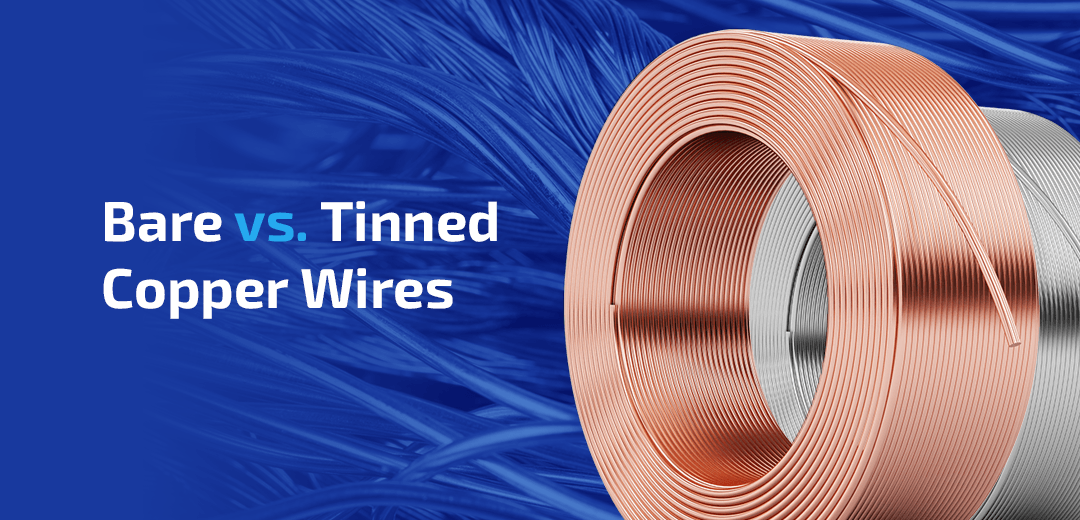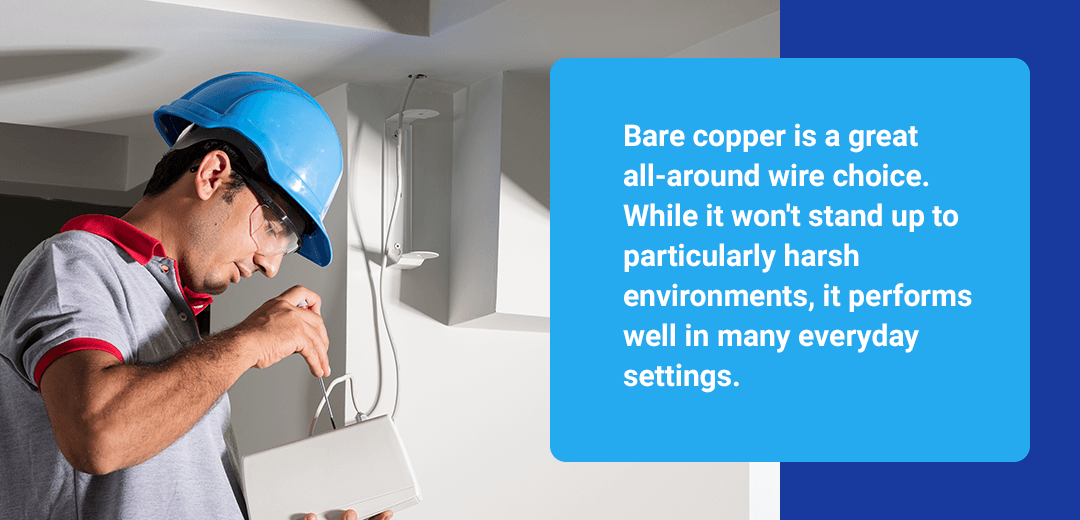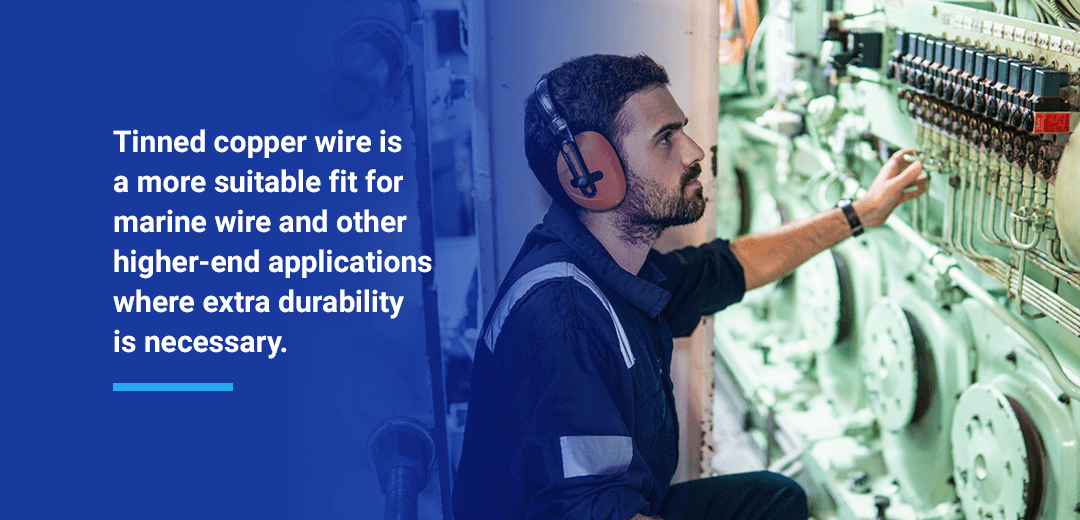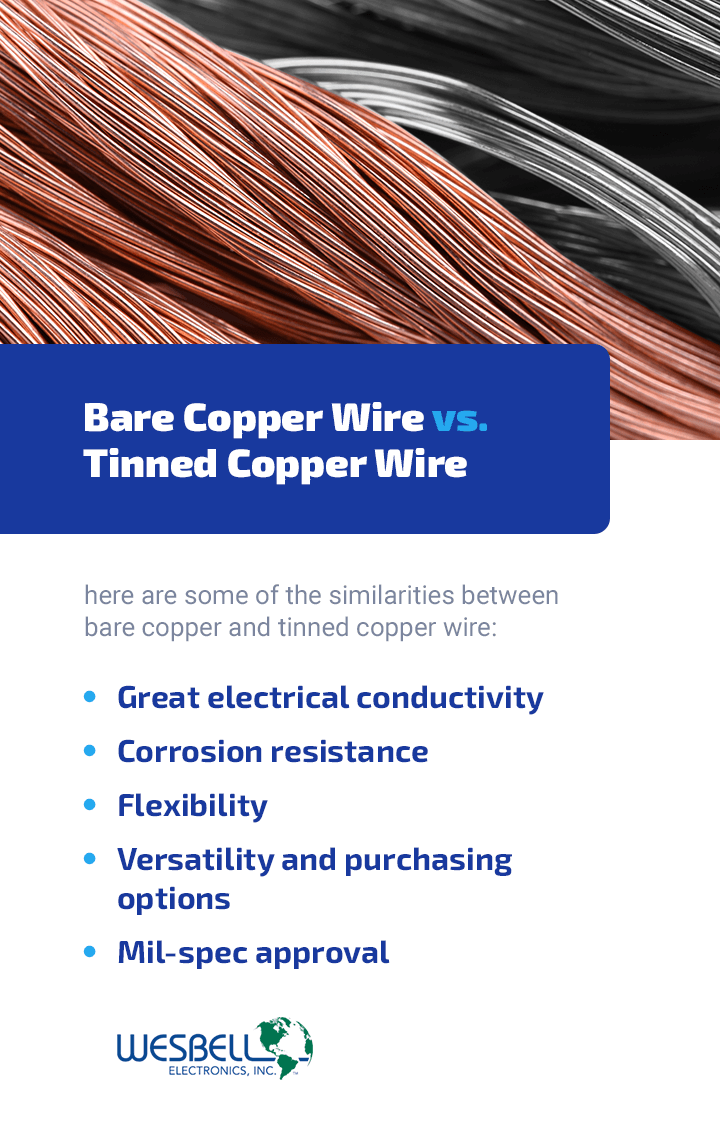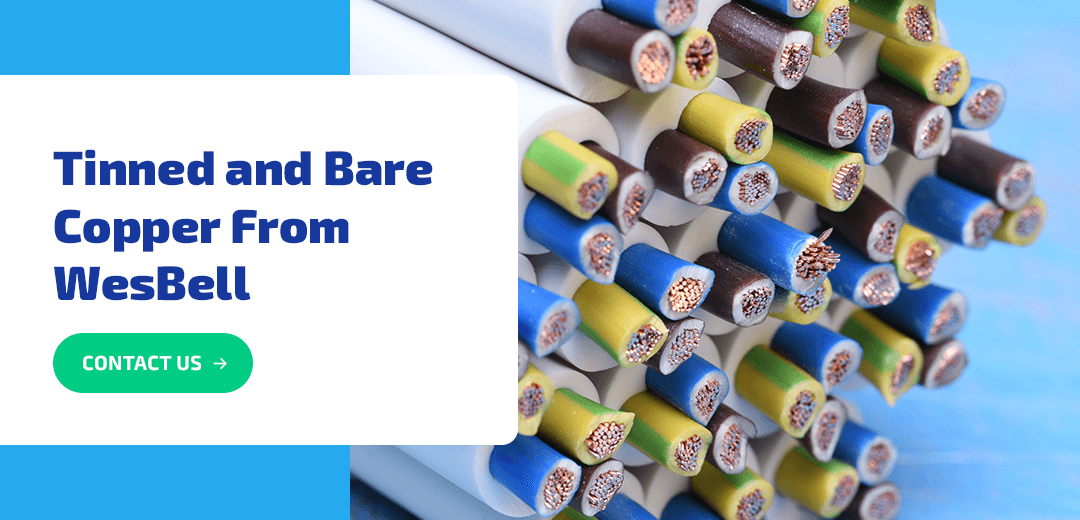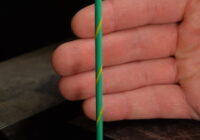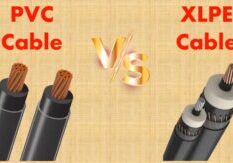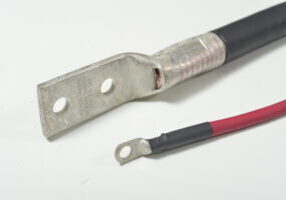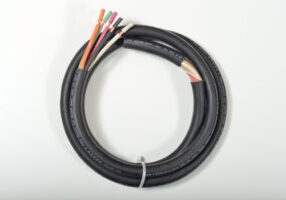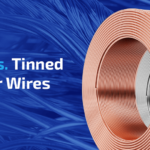
Feb 11, 2022
Bare vs. Tinned Copper Wires
If you need an effective all-around wire, there’s a good chance that copper wire meets your needs. It’s versatile, with powerful electrical conductivity and corrosion resistance, but there are some situations where a layer of tin can add to its capabilities. If you’re using copper wire, you’ll want to consider the difference between tinned copper wire vs. bare copper wire.
What Is Bare Copper Wire?
Bare copper wire offers some of the highest electrical conductivity of all metals, second only to silver. The electrical signal can zip through a copper wire with very little resistance, making it a great choice for applications that range from consumer electronics to power transmission and residential wiring. Unlike silver, copper wire is much more affordable and stands up better to wear and tear. This low cost is a big reason why copper is such a popular choice in the industry.
Along with that excellent electrical conductivity, copper wire offers strong performance for:
- Corrosion resistance: In typical conditions, copper is a durable choice that doesn’t corrode quickly.
- High temperatures: Copper performs well in high-heat environments — generally up to 100 degrees Celsius. It is also heat resistant, making it safer than some materials, especially in residential applications.
- Ductility: Copper bends easily and retains its integrity well when flexed. Being bent or deformed doesn’t hurt its performance.
- Weight: This lightweight metal is often used when weight is considered, such as in aircraft or handheld electronics.
Still, bare copper wire isn’t without its shortcomings. On its own, copper lacks strong insulation. Energy can transfer a little more easily between copper and other wires. Copper can also deteriorate quickly in harsh environmental conditions with moisture or extreme heat. While copper stands up well to flexing on its own, you can also find annealed copper wire, which improves flexing performance by heat-treating the wire.
Copper wire is a popular choice, so it’s available in many sizes. Here at WesBell, we carry it in American Wire Gauge (AWG) sizes 26-2 for various applications — our most popular size is AWG 8. You can buy solid or stranded copper wire by the meter or spool.
Insulated copper wires are another viable option. Along with improving insulation and protecting the cable in some environments, insulation can make the wire easier to work with. It can “label” the wire for easy identification, and the smooth surface of the insulation is often easier to pull through the conduit. Keep in mind that insulation adds to the cost and needs to be stripped before terminating the wire, which can make it more labor-intensive.
What Is Bare Copper Wire Used For?
Bare copper is a great all-around wire choice. While it won’t stand up to particularly harsh environments, it performs well in many everyday settings. It is most commonly used in grounding applications and residential wiring. In residential placements, the copper wire is safely held in the conduit away from harsh environmental stressors. Its flexibility also allows it to wind through tight spots and corners.
Bare copper wire is also commonly used within larger cables. For example, Romex and underground feeder (UFB) cables feature copper grounding wire. Metal-clad (MC) cable also uses copper wire, but it adds a layer of insulation.
Bare copper is a great pick if you need solid electrical performance outside of particularly hot, wet or corrosive environments. Some common uses of bare copper wires include:
- Ground wiring
- Residential wiring
- Various electronics
- Magnet wires in motors and transformers
- Overhead transmission and distribution
- Telecommunications wiring
- Nonelectrical arts and crafts projects
Copper wire is also available as military-specification approved (mil-spec) wire. Mil-spec products are some of the most durable items you can get, built to withstand tough conditions and offer reliable performance. Copper is a good fit for many military applications because of its excellent conductivity and versatility. It is also nonmagnetic and nonsparking, which comes in handy for some installations. Its versatility allows you to use it in many different styles and sizes for unique demands, too.
When used as a ground wire, copper can take on a unique purpose and serve as a “sacrificial” material that takes the brunt of galvanic corrosion. When two metals are in contact with each other and immersed in an electrolyte such as soil and air, galvanic corrosion occurs. One of the metals preferentially corrodes, leaving the other metal to keep working as intended. Copper is sometimes used as a grounding conductor because of this property.
What Is Tinned Copper Wire?
Tinned copper wire is regular copper wire with a tin coating. This tin coating improves some characteristics of the wire and protects it from oxidation. Bare copper does well in many everyday environments, but it can struggle when exposed to humidity, corrosive substances or very high temperatures. In these cases, the layer of tin adds corrosion resistance and helps the wire stay in good shape even in the presence of moisture and heat. It can also keep stranded wires from fraying.
This tin coating protects the copper wire in corrosive environments, such as marine or industrial applications. Like bare copper wire, tinned copper wire can be mil-spec approved and is conductive.
Tinned Copper Wire and Oxidation
Copper undergoes a unique process when it oxidizes. Broadly speaking, oxidation occurs when an atom or compound loses electrons. It often happens when the oxygen in the air reacts with a metal, but other substances like saltwater and heat can speed up oxidation.
Most of us are familiar with oxidation through rust. When iron oxidizes, its molecules turn into the familiar orange material, which flakes off and causes the iron to wear away. When copper oxidizes, it also creates an outer layer, but this layer — called a patina — behaves very differently.
The copper, patina and oxygen undergo many reactions that cause the copper to change from the bronze-red color we know as copper to a light green shade. It progresses through the following colors, eventually stabilizing at green:
- Red
- Dark gray
- Gold metallic
- Blue
- Golden-brown
- Green
The Statue of Liberty is a prime example of the oxidation process. When it first came from France, it was a reddish copper color, and now we know it as a pale green. This process affects the physical properties of the metal, too. The patina serves to protect the copper from further oxidation and corrosion. It forms a barrier between the oxygen in the environment and the bare copper.
A patina is a protective benefit for structures like statues and architectural elements, as it wards off wear and tear. However, when it comes to electrical performance, oxidation decreases the copper’s conductivity and can cause safety issues or shorten its useful lifespan, meaning we want to avoid it in wires. It takes time for a patina to form on bare copper wires, but some environments will significantly speed up the process.
That’s where tin comes into play. Bare copper resists oxidation well on its own, but if exposed to corrosive environments, it needs a little extra help. The layer of tin is in contact with the environment, including any moisture, corrosive agents or heat. Tin can better resist damage and corrosion and forms a barrier against oxygen. It keeps wear and tear at bay and allows the wire to maintain strong performance, even in environments that typically cause quick oxidation.
Why Use Tinned Copper Wire?
Bare copper wire already has good performance in many environments and can resist corrosion well — oxidation is a slow process. You’ll typically only want to use tinned copper if you plan to place the wire in an environment that demands it. Otherwise, bare copper performs well in everyday settings like residential wiring and electronics.
Tinned copper wire is generally only needed if you’re placing the wire in:
- High-heat environments: If temperatures reach 100 degrees Celsius or higher, the tin layer can keep a wire from oxidizing faster in these high temperatures.
- Wet environments: If the cable could be exposed to water, especially saltwater, it should have a tinned layer. These elements cause fast oxidation and destroy the wire.
- Humid environments: Similarly, cables exposed to humidity need extra protection, too. Projects in muggy climates or around steam could be good candidates for tinning.
- Acidic environments: If the cable might come in contact with acidic agents, tin can provide protection.
- Hard-to-access locations: For placements where it may be difficult or costly to access the cable, tinned copper can last up to 10 times longer than bare copper. Tinned wire could limit the need for replacements over time.
These demands make tinned copper wire a suitable fit for marine wire and other higher-end applications where extra durability is necessary. Some common applications for tinned copper wire include:
- Subways
- Marine applications
- Overhead transmission
- Distribution
- Uninsulated hook-ups and jumpers
- Ground wire
- Industrial machinery
You might also choose to use tinned copper wire for an easier soldering experience. Tin is usually the main component in solder and is softer than copper. For less-experienced solderers, the tin layer can make it easier to work with tinned copper wire over bare copper wire.
The additional tin layer doesn’t adversely affect the wire — it simply strengthens the natural properties of copper. Like copper, it’s also an effective electricity conductor. Still, tinned copper is more expensive than bare copper, so bare copper is usually the more cost-effective choice in large projects or projects with limited budgets.
Like bare copper wire, tinned copper wire comes in many options. Here at WesBell, we carry it in AWG sizes 26-2. We offer soft-drawn tinned copper by default, but you can reach out to us for hand-drawn options.
Bare Copper Wire vs. Tinned Copper Wire
Since tinned copper doesn’t take away from the existing properties of bare copper, the choice comes down to your budget and application.
Tinned copper wires are slightly more expensive due to the additional material and processing time required for manufacturing. So, if your project doesn’t need them, it’s best to stick to bare copper wires. Generally, they aren’t needed outside of the hot and humid environments we mentioned above. If you want some extra peace of mind and have the budget to spare, tinned copper wire can strengthen the performance of the wire.
In addition to your budget and application, you’ll want to consider your skill or experience with the wire. If you’ll need to solder, tinned copper can be easier to work with.
Both bare and tinned copper wire are available in many sizes and tempers. Bare copper wire may be available in more styles due to its popularity, but it’s easy to find an array of options for tinned copper wire.
To summarize, here are some of the similarities between bare copper and tinned copper wire:
- Great electrical conductivity
- Corrosion resistance
- Flexibility
- Versatility and purchasing options
- Mil-spec approval
The differences become clear when you’re looking to use the wire in humid or hot locations, where environmental threats might be too much for copper alone to resist corrosion.
Considerations for Buying Tinned Copper vs. Bare Copper Wire
Regardless of which type of wire you’ll be using, you’ll need to keep a few things in mind:
- Standards: Many applications need to meet certain standards from the National Electric Code (NEC) and other authorities. Though some popular standards organizations don’t assess bare copper wire, the NEC has rules about its use. For tinned copper wire, look for the green light from ASTM International with an ASTM B-33 approval, which maintains that the wire meets various performance standards. Military specification AA59551 identifies federal approval for both.
- Seller reputation: Faulty wire can cause big problems. Make sure you’re buying your bare or tinned copper wire from a trusted seller by looking for a long track record of success and assurances from third-party organizations like ASTM International.
- Extra services: If you need to perform tasks like wire harness assembly, cord preparation or cutting to length, it may be more efficient to have someone do those for you. We offer several services that can save you valuable time by ensuring your wires and cables are ready to go when they reach you.
Tinned and Bare Copper From WesBell
Here at WesBell Wire and Cable, you can choose from a variety of bare and tinned copper wire, available by the foot or spool. We also carry other cables that use bare and tinned copper, like UFB and Romex cables.
Our wire comes from reputable manufacturers and is backed by our top-tier customer support. We also specialize in helping you find the right wire for your project. There are many configurations available, and our knowledgeable associates can help you find the ideal combination for your application, budget and preparation demands — all from our ISO 9001:2015 certified quality management system.
If you know what kind of cable you need, browse our bare copper wire and tinned copper wire selections online and get free shipping on orders over $500. Not sure what you need? Not a problem — reach out to us online or at (800) 334-8400 to discuss your project.

